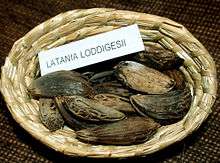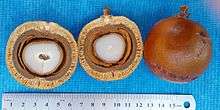Borasseae
| Borasseae | |
|---|---|
.jpg) | |
| Borassus aethiopum in Atakora, Benin | |
| Scientific classification | |
| Kingdom: | Plantae |
| Clade: | Angiosperms |
| Clade: | Monocots |
| Clade: | Commelinids |
| Order: | Arecales |
| Family: | Arecaceae |
| Subfamily: | Coryphoideae |
| Tribe: | Borasseae Mart. |
| Type genus | |
| Borassus | |
| Genera | |
|
Bismarckia Hildebrandt & H. Wendl. | |
Borasseae is a tribe in the palm subfamily Coryphoideae. The tribe ranges from southern Africa and Madagascar north through the Arabian Peninsula to India, Indochina, Indonesia and New Guinea. Several genera are restricted to islands in the Indian Ocean. The two largest genera, Hyphaene and Borassus, are also the most widespread.[1]
Description
Borassoid palms typically have large, column-like trunks, though several species of Hyphaene have branching or clustered stems. The leaves are large, palmate and often with spines or sharp edges along the petioles. Leaves are retained on young palm stems, later falling to reveal prominent scars. All genera in the Borasseae are dioecious, with separate male and female trees; they are pleonanthic, flowering regularly for many years. Inflorescences are large and pendulous; the male flowers are much smaller than the female and are borne in clusters within catkin-like structures. Fruits contain hard, woody endocarps surrounding the seeds; they range in size from date-sized (Latania) to the massive fruits of Lodoicea, which contain the largest seed in the world.[1][2][3]
Taxonomy
The Borasseae is one of eight tribes in subfamily Coryphoideae.[4] The tribe is monophyletic and most phylogenetic studies place it as sister to tribe Corypheae, though it is also close to tribe Caryoteae and tribe Chuniophoeniceae.[3][4] Together, the four tribes make up the syncarpous clade, all members of which have syncarpous ovaries with united carpels.[1]
The eight genera of tribe Borasseae split evenly into two subtribes. In the palms of subtribe Hyphaeninae, both the male and female flowers are sunken within pits and the fruits are stalked and typically one-seeded.[1] Bismarckia (1 sp., B. nobilis) and Satranala (1 sp., S. decussilvae) are endemic to Madagascar, Medemia (1 sp., M. argun) is restricted to Egypt and Sudan, while Hyphaene (8 spp.)[5] ranges from southern Africa and Madagascar to western India. In subtribe Lataniinae, only the male flowers are sunken in pits and the fruits are sessile, with 1-3 seeds.[1] Lodoicea (1 sp., L. maldivica) is endemic to the Seychelles, Latania (3 spp.) is endemic to the Mascarene Islands, while Borassodendron has two species, one in Borneo (B. borneense) and one in the Malay Peninsula (B. machadonis). The last of the genera, Borassus (5 spp.),[6] is the most widespread and is found in Sub-Saharan Africa, Madagascar, Southeast Asia and New Guinea.[6]
Conservation
Many species in tribe Borasseae are threatened with extinction (36% of total recognized species):[7][8]
- Borassodendron machadonis - Vulnerable
- Borassus madagascariensis - Endangered
- Latania loddigesii - Endangered
- Latania lontaroides - Endangered
- Latania verschaffeltii - Endangered
- Lodoicea maldivica - Endangered
- Medemia argun - Critically Endangered
- Satranala decussilvae - Endangered
Gallery
 Female flowers of Latania loddigesii
Female flowers of Latania loddigesii Male flowers of Lodoicea maldivica
Male flowers of Lodoicea maldivica- Male flowers of Lodoicea maldivica emerging from catkin-like inflorescence
 Seed of Lodoicea maldivica, the world's largest seed
Seed of Lodoicea maldivica, the world's largest seed Seed of Latania are the smallest in the tribe
Seed of Latania are the smallest in the tribe Unlike most Borasseae, Hyphaene species often have branching stems (this is H. compressa)
Unlike most Borasseae, Hyphaene species often have branching stems (this is H. compressa) All Borasseae have palmate leaves, as with this Borassus aethiopum
All Borasseae have palmate leaves, as with this Borassus aethiopum The silvery leaves of Bismarckia nobilis make it a popular palm in cultivation
The silvery leaves of Bismarckia nobilis make it a popular palm in cultivation Borassus fruits are large and fleshy, with 1-3 seeds (this is B. aethiopum)
Borassus fruits are large and fleshy, with 1-3 seeds (this is B. aethiopum) Hyphaene fruits have a dry, cake-like flesh and a single seed (this is H. petersiana
Hyphaene fruits have a dry, cake-like flesh and a single seed (this is H. petersiana The massive leaves of Lodoicea maldivica are some of the largest palmate leaves in the family
The massive leaves of Lodoicea maldivica are some of the largest palmate leaves in the family.jpg) Leaf scars on the trunk of Borassus aethiopum are revealed as the leaf sheaths fall off
Leaf scars on the trunk of Borassus aethiopum are revealed as the leaf sheaths fall off
References
- 1 2 3 4 5 Dransfield, John; Uhl, Natalie W.; Asmussen, Conny B.; Baker, William J.; Harley, Madeline M.; Lewis, Carl E. (2008). Genera Palmarum - The Evolution and Classification. International Palm Society. ISBN 9781842461822.
- ↑ Uhl, Natalie W.; Dransfield, John (1987). Genera Palmarum: A Classification of Palms Based on the Work of Harold E. Moore, Jr. Libert Hyde Hortorium. ISBN 978-0935868302.
- 1 2 Bayton, Ross P. (2005). Borassus L. and the Borassoid palms: systematics and evolution. PhD Thesis. University of Reading.
- 1 2 Dransfield, John; Uhl, Natalie W.; Asmussen, Conny B.; Baker, William J.; Harley, Madeline M.; Lewis, Carl E. (2005). "A new phylogenetic classification of the palm family, Arecaceae". Kew Bulletin. 60: 559–569 – via ResearchGate.
- ↑ Stauffer, Fred W. "Hyphaene – A multidisciplinary study". www.hyphaene.org. Retrieved 2018-03-01.
- 1 2 Bayton, R. P. (2007). "A Revision of Borassus L. (Arecaceae)". Kew Bulletin. 62 (4): 561–585. JSTOR 20443389.
- ↑ "The IUCN Red List of Threatened Species". www.iucnredlist.org. Retrieved 2018-03-01.
- ↑ Govaerts, R.; Dransfield, J. (2009). World Checklist of Palms. London: Royal Botanic Gardens, Kew. ISBN 9781842460849.